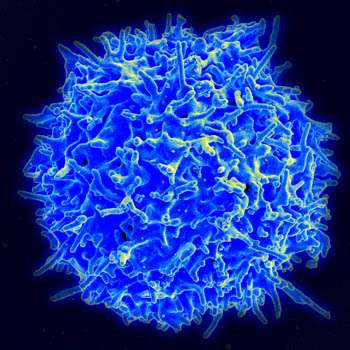Researchers discover a new gatekeeper controlling T cell release into the bloodstream

A team of scientists led by Julie Saba, MD, PhD at UCSF Benioff Children's Hospital Oakland, has unveiled a novel role of thymic dendritic cells, which could result in new strategies to treat conditions such as autoimmune diseases, immune deficiencies, prematurity, infections, cancer, and the loss of immunity after bone marrow transplantation.
The study "Dendritic cell sphingosine-1-phosphate lyase regulates thymic egress," appeared in the Journal of Experimental Medicine (October 17, 2016 issue), published by Rockefeller University Press.
T lymphocytes are blood cells that carry out the main functions of our immune system. Dendritic cells and B lymphocytes are other types of immune cells that present foreign substances (such as microbial proteins) and "self" substances from our own tissues to T lymphocytes. In this way, T lymphocytes are "educated" to distinguish between self and non-self, so they can mount an immune response to pathogens but recognize and remain tolerant of one's own bodily tissues. When this system fails to operate properly, autoimmune disease and immune deficiencies can result.
T lymphocytes undergo maturation in the thymus, a small gland located just above the heart, and are then released into the bloodstream. T lymphocyte egress from the thymus is essential for immune surveillance and to fight various types of infections. Sphingosine-1-phosphate (S1P) is a lipid molecule found at high levels in the blood and low levels in most tissues. Mature T cells produce a cell surface receptor that recognizes S1P, allowing the S1P chemical gradient to attract them into the bloodstream once they have completed their education in the thymus. However, the precise mechanisms that control T lymphocyte egress are not fully understood.
Thymic dendritic cells have a well-established role in antigen presentation and immune tolerance in the body. In addition to this role, dendritic cells also act as metabolic gatekeepers of lymphocyte trafficking. The team showed that thymic dendritic cells take up S1P, a blood borne lipid mediator, and metabolize it through the actions of an enzyme called S1P lyase, generating a localized S1P gradient that facilitates T lymphocyte egress into the blood In light of the fact that dendritic cells are known to continually traffic throughout the body surveying for the presence of infectious agents, the team's observations raise the possibility that dendritic cells could potentially control the release of T lymphocytes in response to various disease states or conditions. These findings provide a deeper understanding of how the body regulates lymphocyte trafficking.
"T cells are needed to orchestrate the body's immune response against pathogenic organisms and also against cancer cells," says UCSF Benioff Oakland's Dr. Julie Saba, one of the study's authors. "In addition to natural T cells, genetically engineered T cells are being used in revolutionary ways to treat cancer. However, conditions such as chronic infection, aging, cancer and bone marrow transplantation can reduce T cell output from the thymus, compromising immune function. By learning what controls T cell output, we hope to be able to restore T cell production when it is low and provide more T cells for therapeutic purposes. "
More information: Jesus Zamora-Pineda et al, Dendritic cell sphingosine-1-phosphate lyase regulates thymic egress, The Journal of Experimental Medicine (2016). DOI: 10.1084/jem.20160287
















